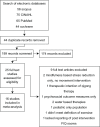Complementary and alternative exercise for fibromyalgia: a meta-analysis
- PMID: 23569397
- PMCID: PMC3616139
- DOI: 10.2147/JPR.S32297
Complementary and alternative exercise for fibromyalgia: a meta-analysis
Abstract
Complementary and alternative medicine includes a number of exercise modalities, such as tai chi, qigong, yoga, and a variety of lesser-known movement therapies. A meta-analysis of the current literature was conducted estimating the effect size of the different modalities, study quality and bias, and adverse events. The level of research has been moderately weak to date, but most studies report a medium-to-high effect size in pain reduction. Given the lack of adverse events, there is little risk in recommending these modalities as a critical component in a multimodal treatment plan, which is often required for fibromyalgia management.
Keywords: complementary and alternative; efficacy; exercise; fibromyalgia; safety.
Figures







References
-
- Jain AK, Carruthers BM, van de Sande MI, et al. Fibromyalgia syndrome: Canadian clinical working case definition, diagnostic and treatment protocols – A consensus document. J Musculoskelet Pain. 2004;11(4):3–107.
-
- Macfarlane GJ. Chronic widespread pain and fibromyalgia: Should reports of increased mortality influence management? Current Rheumatol Rep. 2005;7(5):339–341. - PubMed
-
- White KP, Harth M. Classification, epidemiology, and natural history of fibromyalgia. Curr Pain Headache Rep. 2001;5(4):320–329. - PubMed
-
- Burckhardt CS, Bjelle A. Perceived control: A comparison of women with fibromyalgia, rheumatoid arthritis, and systematic lupus erythematosus using a Swedish version of the rheumatology attitudes index. Scand J Rheumatol. 1996;25(5):300–306. - PubMed
Grants and funding
LinkOut - more resources
Full Text Sources
Other Literature Sources

